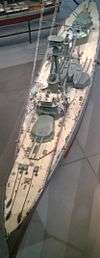HMS Hercules (1910)
 HMS Hercules | |
| History | |
|---|---|
| Name: | HMS Hercules |
| Namesake: | Hercules, divine hero |
| Ordered: | 1908 Naval Estimates |
| Builder: | Palmer |
| Laid down: | 30 July 1909 |
| Launched: | 10 May 1910 |
| Commissioned: | 31 July 1911 |
| Fate: | Sold for scrapping 8 November 1921 |
| General characteristics | |
| Class and type: | Colossus-class battleship |
| Displacement: |
|
| Length: | 546 ft (166 m) |
| Beam: | 85 ft (26 m) |
| Draught: | 26.3 ft (8.0 m) |
| Propulsion: | Steam turbines, 18 boilers, 4 shafts, 25,000 hp (19,000 kW) |
| Speed: | 21 knots (39 km/h) |
| Complement: | 755;up to 800 in wartime |
| Armament: |
|
| Armour: |
|
HMS Hercules was a Colossus-class battleship built by Palmers, launched on 10 May 1910, and commissioned on 31 July 1911 at Portsmouth.
Description
She was a 20,000-ton dreadnought, mounting ten 12 inch (305 mm) guns in five twin gun turrets, sixteen 4 inch (101.6 mm), four 3 pounders, and three 21 inch (533.4 mm) torpedo tubes. She was capable of 21 knots (39 km/h). Her crew numbered 751.
History

She was flagship of the 2nd Division Home Fleet and from July 1912 to March 1913 she was flagship of the 2nd Battle Squadron. On 22 March 1913 during a gale she collided with and damaged SS Mary Parkes of Glasgow, suffering only minor damage herself. In August 1914 she joined the Grand Fleet.
31 May 1916, at the Battle of Jutland, she fought in the 6th Division along with Marlborough, Revenge and Agincourt. She was the 23rd ship in line after deployment. She engaged enemy battlecruisers from 19.00-19.15 achieving hits with her fifth and sixth salvoes. She fired 98 rounds from her main armament during the whole engagement. She was straddled and hit by splinters, but sustained no damage or casualties. Turned to avoid several torpedoes, one of which was seen to pass right alongside.
In June 1916, Hercules was transferred to become flagship of the 4th Battle Squadron. 19 August 1916 she was at sea with the Squadron to intercept the German High Seas Fleet's attempted raid on Sunderland; during this foray she carried out the first test of a towed kite balloon (without observers). 24 April 1918, with HMS St. Vincent she was ordered to Orkney to support Agincourt and the 2nd Cruiser Squadron during the last sortie of the High Seas Fleet. 21 November, Hercules took part in Operation ZZ. She was in the southern line of ships escorting the nine battleships, five battlecruisers, seven light cruisers and 49 destroyers of the Imperial German Navy as they were surrendered to the Grand Fleet and sailed to the Firth of Forth.
3 December 1918, Hercules was detached to take the Allied Naval Armistice Commission to Kiel, returning to Rosyth on 10 December. She was accompanied by the destroyers Verdun, Venetia, Viceroy and Vidette. On this occasion, she flew three Admirals' flags from her single tripod mast. They were flown side by side on the lower yard, a British Vice Admiral's and an American Rear Admiral's on the (senior) starboard side and a French Rear Admiral's on the (junior) port side thus giving equal dignity to each flag. Junior officers commented that it was all very unseamanlike and irreverently speculated whether the yard could stand the strain.
Hercules had a reputation as a "pugilists ship," with many "troublemakers" being posted to her. Discipline was strict. She was equipped with a boxing ring. Breaches of discipline, especially those that resulted in arguments or fights, would very often be dealt with by "volunteering" those involved to fight in the ring. Large wagers were often placed on these bouts by both the officers and men. Another form of punishment meted out was locking miscreants in the brig with a length of used heavy hawser. The offender was allowed out as soon as he had, with his bare hands, unpicked the hawser. This might take days and result in ripped and bleeding nails.
In February 1919 she was reduced to the Reserve Fleet. On 8 November 1921, she was sold to a German ship breaker, Hercules left Rosyth under tow to be scrapped at Kiel.
Museum holdings
The National Maritime Museum's collection includes a number of paintings of Hercules by William Lionel Wyllie.[1][2] Imperial War Museums' collection includes a builders' model of Hercules, made by Palmers in 1910.[3]
References
- ↑ Wylie, William Lionel (1912). "Study of HMS 'Hercules', battleship". National Maritime Museum. Retrieved 23 November 2013.
- ↑ Wylie, William Lionel. "H.M.S. Hercules". National Maritime Museum. Retrieved 23 November 2013.
- ↑ "HMS Hercules (model)". IWM Collections Search. Retrieved 23 November 2013.
- British Warships 1914-1919 by Dittmar, F.J. and Colledge, J.J. Ian Allan, London; (1972), ISBN 0-7110-0380-7
External links
- "H.M.S. Hercules (1910)". dreadnoughtproject.org. 2013. Retrieved 23 November 2013.
Oral history recordings from Imperial War Museums:
- Imperial War Museum (1 June 1992). "Faunce, Bonham de Laune (IWM interview)". IWM Collections Search. Retrieved 23 November 2013.
- BBC Radio Orkney (1987). "Faunce, Bonham de Laune (BBC interview)". IWM Collections Search. Retrieved 23 November 2013.
- Imperial War Museum (22 June 1975). "Hutchings, William Alfred (IWM interview)". IWM Collections Search. Retrieved 23 November 2013.
- Imperial War Museum (1 June 1989). "West, Louis Albert (IWM interview)". IWM Collections Search. Retrieved 23 November 2013.
- Imperial War Museum (1987). "Shaw, Robert John (IWM interview)". IWM Collections Search. Retrieved 23 November 2013.
- BBC (February 1972). "Green, Arthur C (BBC interview)". IWM Collections Search. Retrieved 23 November 2013.
| Wikimedia Commons has media related to HMS Hercules (1910). |
https://ia700200.us.archive.org/9/items/tokielinhercules00freerich/tokielinhercules00freerich_bw.pdf
https://ia700200.us.archive.org/9/items/tokielinhercules00freerich/tokielinhercules00freerich_bw.pdf